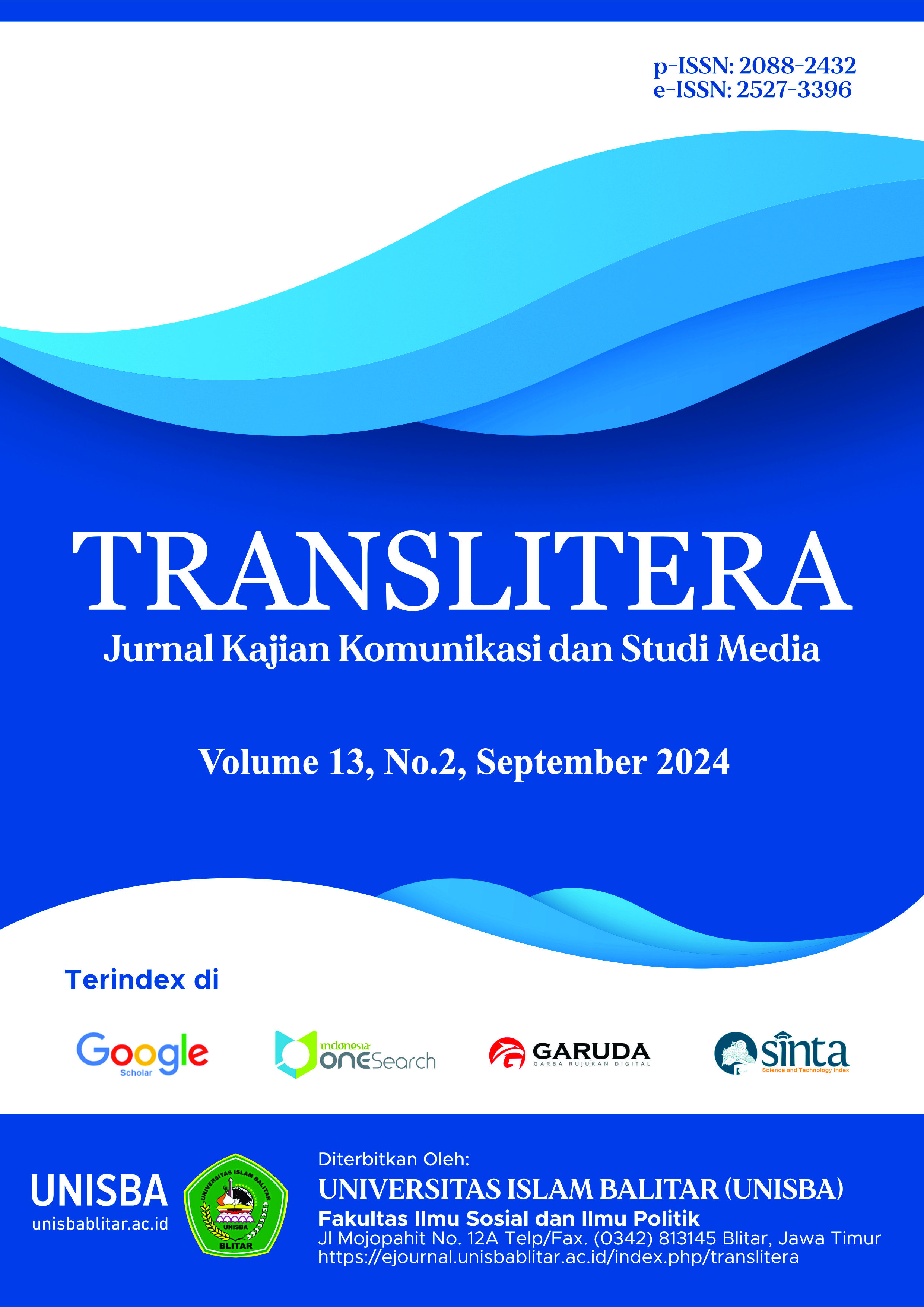Interpersonal Communication Self-disclosure Use of Second account s on Instagram
Study on Communication Science Students Class of 2020 Balitar Islamic University Blitar
DOI:
https://doi.org/10.35457/translitera.v13i2.3893Keywords:
Interpersonal Communication, self-disclosure, second account, InstagramAbstract
This study aims to determine the form and impact of interpersonal communication, self-disclosure, the use of second account on Instagram, a study on Communication Science Students Class of 2020 at Balitar Islamic University Blitar. This research uses qualitative descriptive methods and uses purposive sampling techniques in collecting informants. Data collection using techniques: Interview, Observation, Documentation. The results of this study are forms of interpersonal communication self-disclosure (self-disclosure) on second Instagram accounts, Communication Science Students Class of 2020 photos, videos and meaningful words (quotes) on Instagram stories and feeds. The positive impact encountered, students can get to know themselves, the effectiveness of communication between informants and second account followers, avoid stress, feelings of relief, the emergence of emotional feelings such as empathy and mutual support, and maintain privacy. The negative impact obtained by informants is unpleasant comments, a sense of concern about the perspective of others, and dependence on second account.
References
Annur, C. M. (2024). Ini Media Sosial Paling Banyak Digunakan di Indonesia Awal 2024. Databoks.Katadata.Id. https://databoks.katadata.co.id/datapublish/2024/03/01/ini-media-sosial-paling-banyak-digunakan-di-indonesia-awal-2024.
Budiani, A. N., Fauzi, F., Bantar, G. Y., & Vioga, M. (2023). Gambaran Self disclosure Pengguna Second account Instagram ( Studi Fenomenologi Self disclosure Pengguna Second account Instagram Pada Dewasa Awal ). Jurnal Pendidikan Tambusai, 7(2), 17238–17243.
Haryanto, A. (2024). APJII: Jumlah Pengguna Internet Indonesia Tembus 221 Juta Orang. Inet.Detik.Com.https://inet.detik.com/cyberlife/d-7169749/apjii-jumlah-pengguna-internet-indonesia-tembus-221-juta-orang
Iksandy, D. Y., & Surabaya, U. N. (2022). Dramaturgi Pengguna Second account Di.
Lenaini, I. (2021). Teknik Pengambilan Sampel Purposive Dan Snowball Sampling. HISTORIS: Jurnal Kajian, Penelitian & Pengembangan Pendidikan Sejarah, 6(1), 33–39. http://journal.ummat.ac.id/index.php/historis
Mu’alifah, A. I., & . S. (2023). Self Disclosure Pada Pengguna Media Sosial Twitter (Studi Kualitatif Self Disclosure Pada Pengguna Media Sosial Twitter). Jurnal Signal, 11(1), 01. https://doi.org/10.33603/signal.v11i1.7510
Naurah, N. (2023). Ragam Alasan Orang Miliki Akun Kedua di Media Sosial, Stalking Salah Satunya. Good.Stats.Id. https://goodstats.id/article/ragam-alasan-orang-miliki-akun-kedua-di-media-sosial-stalking-salah-satunya-OCmJc
Ririn Handayani. (2020). Metode Penelitian Sosial. In Bandung (Issue September).
Sari, N.Y., & Wijayanti, A.R. (2024) Peran Media Sosial dalam Fenomena Viralitas (Studi PadaAkunTikTok @Bundacorlaofficials). Perspektif Administrasi Publik dan Hukum,1(3), 49-58.
Sugiyono. (2018). Metode Penelitian Kuantitatif, Kualitatif, dan R&D. Alfabeta.
Sugiyono. (2022). Metode Penelitian Kualitatif. Alfabeta.
Waruwu, M. (2023). Pendekatan Penelitian Pendidikan: Metode Penelitian Kualitatif, Metode Penelitian Kuantitatif dan Metode Penelitian Kombinasi (Mixed Method). Jurnal Pendidikan Tambusai , 7(1), 2896–2910.
Yonatan, A. Z. (2023). Pengguna Instagram Berdasarkan Rentang Usia 2023. Data.Goodstats.Id. https://data.goodstats.id/statistic/agneszefanyayonatan/pengguna-Instagram-berdasarkan-rentang-usia-2023-MEdzz
Downloads
Published
Issue
Section
License
Authors who publish with this journal agree to the following terms:
- Copyright on any article is retained by the author(s).
- Author grant the journal, right of first publication with the work simultaneously licensed under a Creative Commons Attribution License that allows others to share the work with an acknowledgement of the work’s authorship and initial publication in this journal.
- Authors are able to enter into separate, additional contractual arrangements for the non-exclusive distribution of the journal’s published version of the work (e.g., post it to an institutional repository or publish it in a book), with an acknowledgement of its initial publication in this journal.
- Authors are permitted and encouraged to post their work online (e.g., in institutional repositories or on their website) prior to and during the submission process, as it can lead to productive exchanges, as well as earlier and greater citation of published work.
- The article and any associated published material is distributed under the Creative Commons Attribution-ShareAlike 4.0 International License












